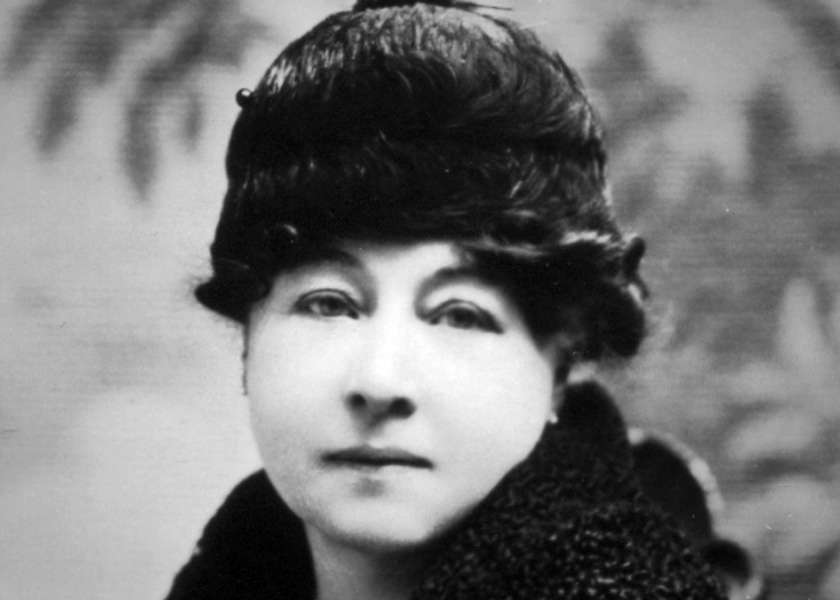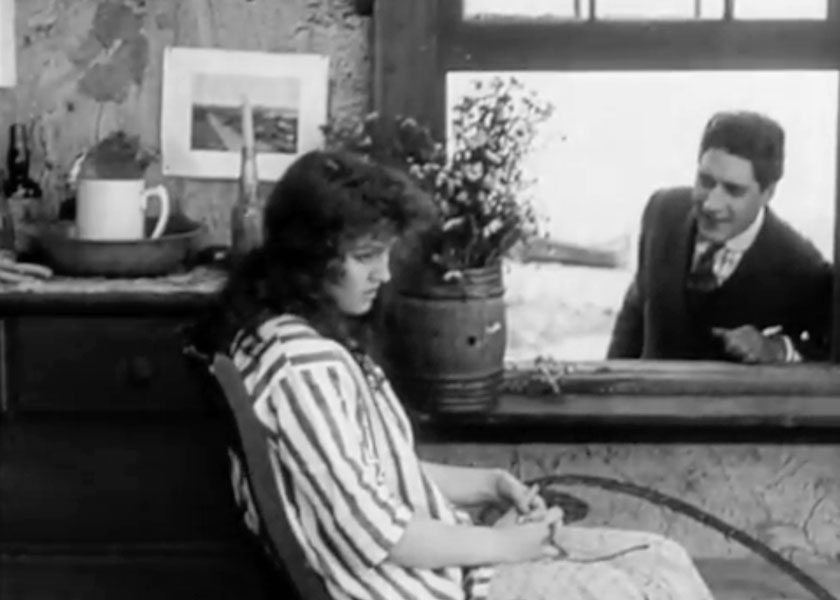Synopsis
Millie Jessop (Kenyon), returned from wandering in the woods, is berated by her stepfather, Hy Jessop (Morris). Jessop does not like the dinner Millie serves and starts to beat her. Sem (Frauholz), the handicapped neighbor boy who loves Millie, intervenes, and Millie runs away, vowing never to return. Millie, despite her fear of the mice scurrying about, hides in a large, recently deserted house. Ronald Roberts (Blackwell), a novelist looking for a secluded spot in which to write, takes the house, not knowing that Millie is living in it. Ronald’s valet, Hawkins (Norton), who has been told the house is haunted by a young woman, is fearful of meeting the ghost, but Ronald laughs at his fears.
Millie takes food from the kitchen without being seen. During the night, Ronald
hears her movements and investigates. He is surprised to find a young woman; she
tells him that she is hiding from a brutal stepfather. Ronald shelters Millie in
the house. Millie finds a dress and petticoat in her room, dresses in them, and
styles her hair. Ronald notices how pretty she is. Millie tells her story to
Ronald. As a young child, she had washed ashore from a sunken ship, and Hy adopted
her. Ronald immediately decides that the story of the ocean waif
will be a
perfect plot for his new novel. He sits up most of the night writing.
Despite his engagement to a beautiful young woman, Ronald is attracted to lovable Millie. Of course, she is in love with him. Ronald is expecting a visit from his fiancée, and on the day Ruth (Donaldson) and her mother arrive, Ronald, who cannot stop himself, is kissing Millie. Ruth sees them. Ronald tries to explain, but Ruth is angry. Millie, realizing that she is the cause of Ruth’s anger, returns to her stepfather’s shack. Ronald admits that he loves Millie. Ruth decides to leave, announcing that she is engaged to the rather silly Count who has been accompanying them and flirting with Ruth’s mother. The mother is understandably piqued at this announcement.
Ronald, not knowing that Millie has gone back to Sy’s house, decides to go hunting and buys some bullets. Sem is also buying bullets. Ronald, walking through the fields, shoots at some game animals. At his shack, Hy realizes that Millie is a pretty young woman and not his own child. He decides to marry her. Hy seizes Millie and attempts to kiss and fondle her; she fights him. Sem, looking through the window, shoots Hy and then runs away. Ronald arrives about this time. As he checks the condition of Hy, some local men enter and assume that Ronald, who is carrying his gun, has shot Hy. He is arrested.
Ronald is being tried for murder. Millie tells Sem how much she loves him and how frightened she is that he will be convicted. Sem gives Millie a confession to take to the sheriff. Ronald is released. Sem kills himself. Ronald and Millie look forward to their happiness.
Discussion
The Ocean Waif might be of only minor interest except for the fact that it was produced and directed by the first female film director, Alice Guy-Blaché, and is one of only three of her more than forty feature films known to survive. (More than 130 of the short films she produced, directed, wrote or supervised between 1896 and 1913 are extant). The rudimentary plot features a series of improbable events that culminate in the expected union of the lovers. The characters — innocent girl, noble handsome novelist, easily frightened valet, handicapped neighbor boy, and brutal stepfather — are well-known stereotypes of the time. Mille Kenyon, portraying the central character, does the best acting, effectively conveying a range of powerful emotions without excessive emoting. Costar Carlyle Blackwell radiates charm and good spirits but is less effective at projecting varying emotions.
Contemporary reviews of The Ocean Waif in
Moving Picture World and Motography praised the actors, especially
Kenyon, and the general entertainment value of the picture. Both reviews also
noted the familiarity of the story elements, such as the orphaned child raised by
a drunken fisherman and the hero accused of a killing he did not commit. The basic
plot and characters had been used frequently on stage and screen. Although neither
reviewer names Guy-Blaché, Motography notes that the
direction is not of such character as would realize the best that the material
offered.
The film was not commercially successful.

Alice Guy-Blaché began her career in 1896 for the French film company Gaumont. In France she directed, produced and supervised hundreds of mostly one-reel silent short films, and another 150 synchronized sound films using the Gaumont Chronophone system (patented in 1902 by Léon Gaumont). Her most ambitious Gaumont project was La Vie du Crist (1906), filmed in 25 scenes. She married her husband Herbert Blaché in 1907, and the couple moved to New York where Herbert was sent to manage Gaumont's American subsidiary.
In 1910, Guy-Blaché and Herbert founded their own studio, Solax Film Company. Guy-Blaché made her films at the Gaumont studio, producing and directing one or two one-reel films a week. In 1912 Guy-Blaché built a studio for Solax in Fort Lee, New Jersey, where many other film studios were also located. At this location, the studio produced three one-reel films a week, at least half of them written and directed by Guy-Blaché. The Solax films were distributed through Gaumont until the French company left the US at the beginning of World War I.
In 1913, Guy-Blaché moved to feature film (five or more ten-minute reels) production. For several years, she gave up being independent and made films in the Solax studio for the production company Popular Plays and Players. Returning to independent production in 1916, she directed seven films, including The Ocean Waif, that were distributed by a variety of companies. The Ocean Waif was distributed by the International Film Service, owned by newspaper magnate William Randolph Hearst. In 1917, she made four films with a young actress named Catherine Calvert; these films flopped at the box office. In fact, many of Guy-Blaché’s feature films had not been commercially successful.
In 1918, Guy-Blaché directed The Great Adventure, a comedy, that had good box office returns. However, her filmmaking career was nearly finished. In early 1919, she made her last film, Tarnished Reputations, for the independent production company Perret Pictures. Later that year, she followed Herbert to Hollywood where she assisted him on a couple of films, but mostly she was without work. By 1922, Guy-Blaché's marriage had collapsed, and she returned to France with her children. Guy-Blaché attempted, but failed, to find work in the French film industry. After 28 years of filmmaking, her career was over.
For the remainder of her life, Guy-Blaché lived with her daughter, upon whom she was financially dependent. After World War II, living in Washington, D.C., she was writing her memoirs and compiling a filmography. In her later years, Guy-Blaché was recognized in France for her pioneering work. Film historians, such as Jean Mitry and Victor Bachy, researched and wrote about her career. In 1955, she was awarded the Légion d’honneur, France’s highest nonmilitary honor. She was honored in a Cinémathèque française ceremony in 1957. In 1963, she was interviewed for the television show Hieroglyphes. Guy-Blaché's autobiography was published posthumously in 1976, and an English translation released in 1986.
Carlyle Blackwell was one of the first movie idols. He began with the Vitagraph Movie Company in 1910, and subsequently acted for Kalem Company and Jesse L. Lasky Pictures. Reputedly the first male star to earn a four-figure weekly salary, Blackwell is said to have made $2000 a week in 1914. His peak may have been in 1916 when his popularity was so high that his attendance at a reception in Madison Square Garden attracted a large gathering of mostly female fans inside and outside the venue. By 1920, Blackwell’s stardom had waned. He relocated to England where he starred in films through the 1920s. In 1930, with his own company, Carlyle Blackwell Productions, he produced, directed, and starred in his only two talkies and final films. Few of the over 300 short and feature films made by Blackwell are available for viewing today.
Further Reading

